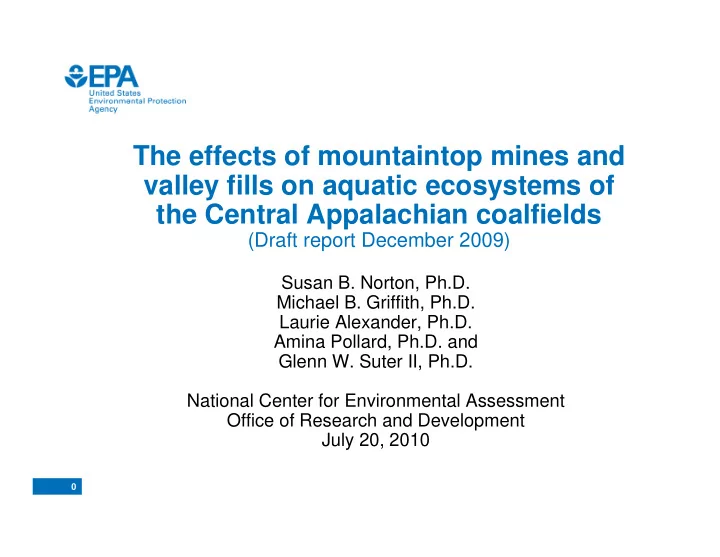

The effects of mountaintop mines and valley fills on aquatic ecosystems of the Central Appalachian coalfields (Draft report December 2009) Susan B. Norton, Ph.D. Michael B. Griffith, Ph.D. Laurie Alexander, Ph.D. Amina Pollard, Ph.D. and Glenn W. Suter II, Ph.D. National Center for Environmental Assessment Office of Research and Development July 20, 2010 0
What we did � Evaluated evidence of MTM-VF effects on aquatic systems � Headwater and forest resource loss � Water quality � Downstream aquatic ecosystems � Cumulative impacts of multiple mines � Reclamation, mitigation and recovery � Out of scope: � impacts of coal processing or transport � slurry impoundment failure, truck traffic, etc. � human health or social impacts 1
Literature Reviewed � Two sources � Peer-reviewed literature � Studies conducted as part of a US EPA Programmatic Environmental Impact Statement (USEPA 2003, 2005) � Searches conducted using ISI Web of Science and Google Scholar � End date of searches = August 2009 � Review cites 177 different sources of information. � Few (6) peer-reviewed articles investigated effects of MTM-VF on aquatic ecosystems within the study area. � Useful literature was available from other types of mining, other regions, laboratory experiments, knowledge of processes and mechanisms. 2
3
The Central Appalachian Mountains have been identified as a significant region of biological diversity in the continental United States. Rarity-Weighted Richness Index Low High
Earth movement by humans (panel a) and rivers (panel b) in gigatons/annum. Source: Hooke 1999
Hobet 21 Mine Washington, DC Bar on both maps = 7 miles 6 Source: Google Maps, accessed 11/18/2009
Mining Permit Boundaries in Southwestern WV A 7 Source: http://gis.wvdep.org/imap/index.html, accessed 10/27/2009
8
Streams are lost � Springs, intermittent streams and perennial streams are buried beneath fill and lost along with the mountaintop � 1900 km of stream estimated to be lost from permits approved between 1992-2002 � 2% of streams in the study area � 3x length of Potomac River � Inventory of MTM-VF extent has not been updated since 2002 9
Chemical ions are elevated � Concentrations of ions (esp. SO 4 2- , HCO 3 - , Mg 2+ , Ca 2+ ) increase around 10X in effluent downstream of sediment retention ponds and valley fills � Mean concentrations: 62 µS/cm unmined vs 1020 µS/cm mined � Mixture measured as specific conductivity, total dissolved solids, or salinity � Concentrations of ions have increased over time 2- concentrations increased 1.6X between 1980 and � e.g., Median SO 4 1998 in larger streams of the Kanawha Basin 10
Degraded water quality reaches levels that are acutely lethal to aquatic invertebrates � Effluent with high conductivity from toe of fill and sediment retention ponds is lethal to Ceriodaphnia dubia in short term toxicity tests � Observed effects are consistent with C. dubia toxicity models (Mount et al. 1996) � 75% mortality predicted at highest conductivity observed. � Ions likely interact to cause effects: not simple concentration or response addition (Mount et al. 1996, Soucek 2007, Soucek and Kennedy 2005). - ~ Mg 2+ > Cl - > SO 4 2- > Ca 2+ ~ Na + � Relative ion toxicity: K + > HCO 3 � High hardness ameliorates sulfate toxicity � Low chloride concentrations may increase sulfate toxicity � Other organisms (e.g., Hyalella azteca ) more sensitive than C. dubia 11
Selenium concentrations are elevated � Concentrations of selenium increases about 10x in effluent downstream of sediment retention ponds and valley fills � Mean concentrations: <1.5 µg/L unmined vs. 11 µg/L mined � Selenium concentrations in many streams exceed EPA’s chronic Ambient Water Quality Criterion for selenium of 5 µg/L. � In British Columbia reproductive effects have been observed in fish and birds below surface mines with elevated Se. 12
Macroinvertebrate and fish communities are degraded � Assessments of stream community condition (using both fish and benthic macroinvertebrates) show poorer quality downstream of MTM-VF � All studies show declines in Ephemeroptera taxa downstream of MTM-VF � Macroinvertebrate indices strongly correlated with conductivity (e.g., r =- 0.81 for West Virginia SCI, Pond et al. 2008) 13
What about reclamation, mitigation and recovery? � Acidic drainage is largely neutralized � Sediment retention ponds do not reduce either ion or selenium concentrations � Studies examining whether constructed ditches replace functions or fauna of original headwaters are underway, but were not published at time of review. 14
Next Steps � Draft report available at www.epa.gov/ncea � Look under “recent additions” � EPA’s Science Advisory Board (SAB) review � Public comments received by July 13, 2010 provided to SAB � Public review period ends August 13, 2010 � ORD.Docket@epa.gov � http://www.regulations.gov � Docket ID No. EPA-HQ-ORD 2009-0934 � Report will be finalized based on Science Advisory Board and public comments 15
Recommend
More recommend